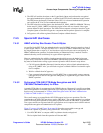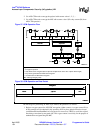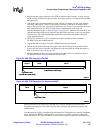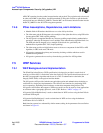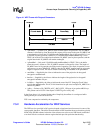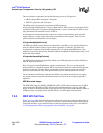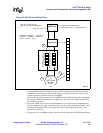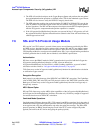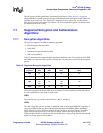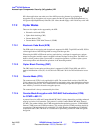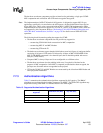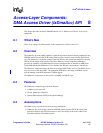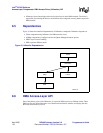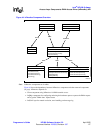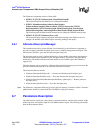
Intel
®
IXP400 Software
Access-Layer Components: Security (IxCryptoAcc) API
Programmer’s Guide IXP400 Software Version 2.0 April 2005
Document Number: 252539, Revision: 007 111
The ixCryptoAccAuthCryptPerform() functionality described in “IPSec Services” on page 96
offers capabilities to perform encrypt /decrypt AND authentication calculations in one submission
for IPSec style clients only. This “single-pass” method does not work for SSL and TLS clients.
SSL and TLS clients must register two contexts; one for encryption/decryption only and the other
for authentication create / verify.
7.7 Supported Encryption and Authentication
Algorithms
7.7.1 Encryption Algorithms
IxCryptoAcc supports four different ciphering algorithms
• Data Encryption Standard (DES)
• Triple DES
• Advanced Encryption Standard (AES)
• ARC4 (Alleged RC4)
Table 12 summarizes the supported cipher algorithms and the key sizes. The actual key size in DES
and 3DES is less because every byte has one parity bit. The parity bit is not used in the encryption
process.
The order expected by the Security Hardware Accelerator is in the network byte order (big endian).
It is the responsibility of the client to ensure order.
3DES
The order the keys are passed in should be Key 1, Key 2, and Key 3.
ARC4
The ARC4 algorithm can only be used in standalone mode or along with WEP-CRC algorithm. It
cannot be combined with any other authentication algorithms, like HMAC-SHA1 and HMAC-
MD5. ARC4 keys used in WEP are generally 8 bytes (64-bit) or 16 bytes (128-bit). The ARC4
engine expects to be passed a key of 16 bytes in length, where it then copies the key to fill a
256-byte buffer. Therefore, if the key being used by the client is 8 bytes long, then the client should
repeat it to fill the 16 bytes of key buffer.
Table 12. Supported Encryption Algorithms
Cipher
Algorithm
Key Sizes
(Bits)
Parity Bit
(Bits)
Actual Key Size
(Bits)
Plaintext / Ciphertext Block Size
(Bits)
DES 64 8 56 64
3DES 192 24 168 64
AES
128
192
256
NA
128
192
256
128
ARC4 128 NA 128 8



